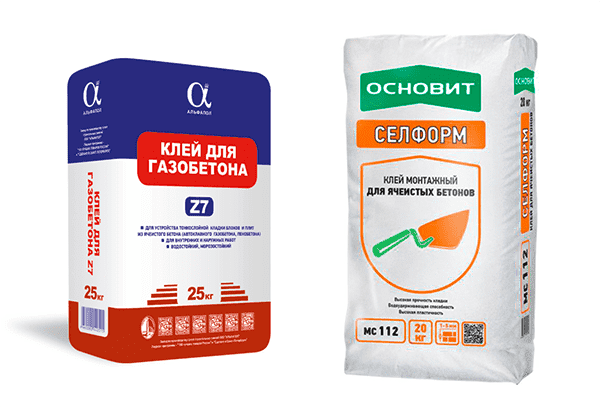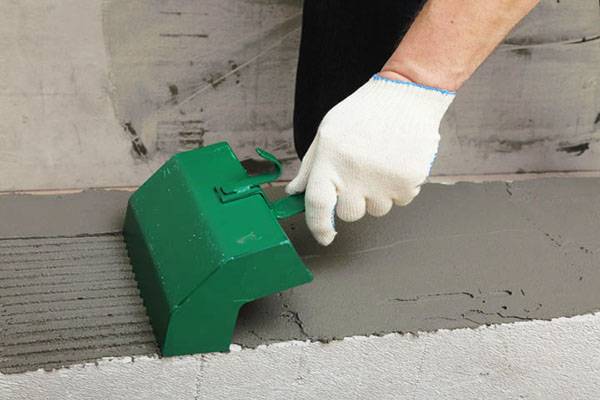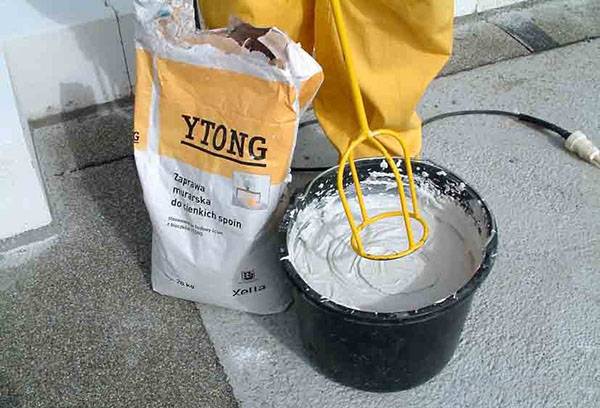Features of working with glue for aerated concrete
Content:
Often during construction it becomes necessary to choose a good adhesive for aerated concrete. There are different brands of this material - if you use the composition with the necessary additives, you can perform work even in winter, the quality of the masonry will not suffer. Blocks can also be placed on ordinary cement mortar, but its thermal conductivity is higher than that of cellular blocks, and therefore, through thick joints, the heat from the house will go outside. Try new materials, they are simple and convenient.
The composition of the adhesive for aerated concrete, the pros and cons of the material
The glue is based on high-quality Portland cement. In combination with sand, this material is used to prepare mortars, and with the introduction of additional components, new mixtures are obtained for connecting bricks and blocks.
In addition to cement, the following components are added to the dry composition:
- natural mineral fillers, most often it is fine sand;
- polymer components, for example polyurethane powder for ductility;
- antifreeze additives for the winter mixture.
2 types of glue are produced. The white mixture is suitable for work in the warm season or in winter in a heated room. When hardening, the seams acquire the color and texture of the blocks, become invisible. The wall is homogeneous, you can not finish it. Gray glue for aerated concrete blocks is suitable for work in any season, if the temperature does not fall below -10⁰C.
Tip
If you work at sub-zero temperatures, make sure that the solution does not cool below 0⁰C.
The developers created a mixture with physical properties that are as close as possible to the characteristics of aerated concrete - after hardening, the same foam is obtained that is used in the manufacture of porous masonry stone. A structure composed of such a set of materials can be considered monolithic; at temperature extremes, compression and expansion occurs uniformly over the entire area, and the joints do not crack. Glue for gas block even with a thickness of 1 mm reliably fastens the structure.
Other benefits of glue:
- ease of preparation of the working solution;
- strong fastening of blocks;
- plastic;
- lack of shrinkage when drying;
- quick setting;
- ease of applying the composition.
When laying aerated concrete on glue, the thickness of the seam is from 2 to 4 mm, the blocks are tightly adjacent to each other. As a result, the material is consumed economically, you do not need to import a lot of bags of dry mix to the construction site. After solidification of the solution, a durable, waterproof, frost-resistant design is obtained.
The disadvantages of the material include the fact that for masonry, you can use only smooth blocks with a flat surface of all faces. Chips, potholes, cracks are not allowed. If you purchased a cheap substandard aerated concrete with deviations from the geometric shape, a solid structure will not work. Another minus is the small “life time” of the prepared solution. If a person does not have sufficient experience and works slowly, and it is winter outside, he will have to stop every half hour and prepare a new portion of the working staff.
How to put a gas block on glue?
Before starting masonry, you need to prepare a working solution. Measure the temperature of the water you will be pouring the dry mixture into, it should be between 15 and 18⁰C. If you take water from a spring or a well in a summer house, it may turn out to be too cold. Place a bucket in the sun so that the liquid heats up. High-quality glue for aerated concrete blocks will turn out only if you follow all the rules for its preparation.
Of the equipment and tools for the job you will need:
- measuring dishes and scales;
- container for kneading;
- electric drill and nozzle "construction mixer";
- bucket for applying adhesive;
- notched metal spatula;
- rubber mallet to adjust the installed block;
- saw with carbide tines;
- shtroborez;
- graters for cleaning surfaces.
Important!
Do not measure the components “by eye”, you may make a mistake, and if the ratio is incorrect, the seam will not be strong enough.
Pour the dry mixture into a tank of sufficient volume, add water in the required proportion and mix the solution with an electric drill. It’s better not to try to manually stir the composition, it will take a lot of time, and the glue may turn out to be mixed unevenly, with lumps. Let the solution brew for 10 minutes and knead a second time. To prepare a solution for work in the cold season, knead aerated concrete glue in water at a temperature of + 60 +C. Do not direct a large amount, the finished mixture in winter needs to be used in half an hour, otherwise it will lose its quality.
Before applying glue, the surface must be cleaned of dust, dirt, grease stains, dry wet areas. Moisten glue spots slightly with water. Apply glue with a thin layer using a notched trowel. Coat all horizontal and vertical surfaces that the gas block will come into contact with and set it in the desired position. If you accidentally install the unit unevenly, its position can be corrected within 10 minutes. After work, cover the structure with tarpaulin so that the solution does not dry out too quickly.
Tip
When working, keep measuring instruments on hand: level, rail, plumb. From time to time, check to see if the structure is even and if there are any deviations from the plane.
To work at positive temperature, you can take a special glue for aerated concrete "KREPS". It contains a very small filler, so the seam is obtained with a thickness of not more than 3 mm. A bag weighing 25 kg is enough for 1 m3 masonry, the working life of the working solution is 4 hours. The glue sets for 10 minutes, during which time you can fix a poorly laid block.
Glue consumption calculator - self-calculation
The flow rate of the solution and the proportions of water and dry mix are indicated on the packaging or in the instructions for the adhesive. Usually for 1 kg of dry sweep you need to take from 200 to 220 ml of water. A bag will require 5 to 5.5 liters. Do not ignore the manufacturer's recommendations, because the technology and composition of the adhesive are constantly being improved, and for a new material, a different ratio of liquid to dry matter may be required.
The flow rate of the working solution is affected by:
- qualifications and experience of the builder;
- seam thickness;
- quality of tools;
- surface condition;
- weather.
For an approximate calculation of the required amount, it is recommended to take 1 bag (25 kg) for 1 m3 masonry with a joint thickness of 3 mm. Experienced craftsmen themselves know how much material they will need to work, and adjust the recommended amount to a greater or lesser extent. If this is your first time working with aerated concrete, it is better to get at least 1.5 bags per 1 m3. Most likely, at the first attempt, you will not be able to apply the composition with a sufficiently thin layer and the material consumption will increase.
Important!
Do not forget to buy ordinary cement for the preparation of masonry mortar. At the beginning of work, the first row of blocks must be laid out on the composition, which is used for brick walls, and only the following stones are put on glue.
Beginners in the construction business are better off working in the summer. Be sure to read all the recommendations on the packaging of the mixture or in the instructions. On the first day, it is advisable to do the laying under the guidance of an experienced craftsman. He will check how correctly you knead the solution, indicate errors in applying the composition to the surface. When you understand the basic rules, and things will go faster, and material consumption will decrease.In a few days, you will learn convenient working methods: glue for aerated concrete was created with the expectation of convenience and simplicity. Do not forget that the white composition is suitable only in the summer, in the cold you need to use special winter stamps.
Aerated concrete is an excellent building material, with a small weight it serves as a good heat insulator. All the advantages of gas blocks can appear only when they are laid on the correct adhesive. Take the time to read the information on the packaging of several brands of glue, compare their qualities, choose which is best suited to your conditions. Do not hesitate to ask for advice from the manager of the trading company or professional builder, they will explain what mixture is intended for which work. In a room with an unsuccessful decoration, you can live for a while, and then make redecoration, but the supporting structures must immediately be installed reliably and firmly. Take on the matter with all responsibility, and if you are not confident in your abilities, entrust the work to a team of craftsmen.


